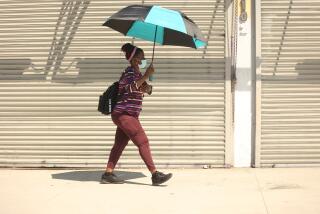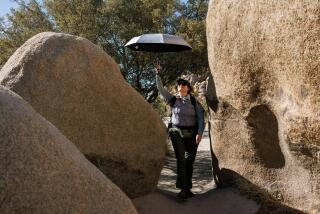Drivers should carry tools, water and other items in case of an emergency on the road. Air conditioning should be turned off on steep inclines.
- Share via
Because even well-maintained cars can break down, carry items for safety and comfort such as:
* Drinking water and a windshield shade for reducing heat build-up inside the vehicle.
* A cellular telephone or citizens band radio for summoning help.
* An emergency kit containing a flashlight with extra batteries.
* Warning devices such as flares or reflective triangles.
* Jumper cables and a first-aid kit.
* A basic tool kit.
* A gallon of water and a gallon of antifreeze.
* Motorists should be prepared for the effects of hot weather while driving. The Automobile Club of Southern California cautions against leaving children and pets inside a parked vehicle in hot weather, because temperatures can exceed 120 degrees on days when outside temperatures reach 100 degrees. Not only is this dangerous, but motorists who leave children unattended in parked cars can be prosecuted.
* If the vehicle’s temperature starts to climb while driving, motorists should turn off the air conditioning and turn on the heater to draw heat off the engine. This will help cool the engine. The air conditioning should also be turned off when climbing steep hills or inclines such as the Grapevine. This will decrease the demands on the engine and reduce the potential of overheating.
Source: Automobile Club of Southern California
Product commission to develop rules to make portable bed rails safe for children.
The Consumer Product Safety Commission has voted to develop mandatory safety standards for portable bed rails.
The standards will be designed to reduce the risk of entrapment and strangulation. The commission said it took the action because the industry has failed to adopt a voluntary standard.
Portable bed rails are intended for use on full-size beds to prevent children from falling out. In the past 10 years, the commission has learned of 14 deaths of children, most of whom were under age 2, who became trapped in a space between the bed rail and the mattress, as well as 40 other accidents.
Despite manufacturers’ labels saying bed rails are meant for children ages 2 through 5, and commission warnings against placing younger children to sleep on full-size beds, parents sometimes put children under 2 on beds when a crib is not available.
If the rail is pushed out from the mattress, young children can fall into the space and suffocate or strangle. The commission staff believes a new rail design could eliminate the danger.
The first step to creating regulations will be a notice in the Federal Register, followed by a comment period.
You can learn more by going to https://www.cpsc.gov






